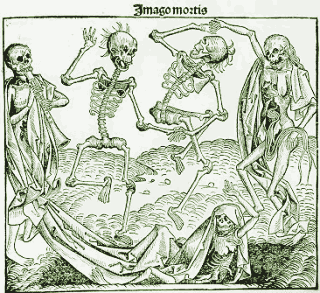Memento mori
|
|
Memento mori is a Latin phrase that means "Remember that you are mortal" (or literally "remember mortality"). It names a genre of artistic creations that vary widely from one another, but which all share the same purpose, which is to remind people of their own mortality.
In ancient Rome, the phrase is said to have been used on the occasions when a Roman general was parading through the streets of Rome. Standing behind the victorious general was a servant, and he had the task of reminding the general that, though he was up on the peak today, tomorrow was another day. The servant did this by telling the general that he should remember that he was mortal, i.e. "Memento mori", although it is more likely that the servant said "Respice post te! Hominem te esse memento!" (Look behind you! Remember that you are but a man!) as Tertullian has written in chapter 33 of his work Apologeticus.
Memling_Vanity_and_Salvation.jpg
The genre was little used in classical antiquity; there, the chief thrust of memento mori was the theme of "carpe diem", "seize the day", which would have entailed the advice to "eat, drink, and be merry, for tomorrow we die." The Christian origin of this quote is from Isaiah 22:13, (from the New American Bible): " Eat and drink, for tomorrow we die!" But the thought appears outside the Bible: in the Odes of Horace, with the well known line Nunc est bibendum, nunc pede libero pulsanda tellus. (Now is the time to drink, now the time to dance footloose upon the earth.) Horace goes on to explain that now is the time because there will be no drinking or dancing in the afterlife. This is the classic carpe diem theme.
But the thought came into its own with Christianity, whose emphasis on Heaven, Hell, and the salvation of the soul brought death to the forefront of consciousness. As such most memento mori works are products of Christian art. In the Christian context, the memento mori acquires a moralizing purpose quite opposed to the Nunc est bibendum theme of Classical antiquity. To the Christian, the prospect of death serves to emphasize of the emptiness and fleetingness of earthly pleasures, luxuries, and achievements, and thus also as an invitation to focus one's thoughts on the prospect of the afterlife. A Biblical injunction often associated which the memento mori in this context is In omnibus operibus tuis memorare novissima tua, et in aeternum non peccabis (the Vulgate's Latin rendening of Ecclesiasticus 7:40, "in all thy works be mindful of thy last end and thou wilt never sin.")
The most obvious places to look for memento mori meditations are in funereal art and architecture. Perhaps the most striking to contemporary minds is the transi, or cadaver tomb, a tomb which depicts the decayed corpse of the deceased. This became a fashion in the tombs of the wealthy in the fifteenth century, and surviving examples still create a stark reminder of the vanity of earthly riches. The famous danse macabre, with its dancing depiction of the Grim Reaper carrying off rich and poor alike, is another well known example of the memento mori theme. This and similar depictions of Death decorated many European churches. Later, Puritan tombstones in the colonial United States frequently depicted winged skulls, skeletons, or angels snuffing out candles. See the themes associated with skull imagery.
Timepieces were formerly an apt reminder that your time on earth grows shorter with each passing minute. Public clocks would be decorated with mottos such as ultima forsan ("perhaps the last" [hour]) or vulnerant omnes, ultima necat ("they all wound, and the last kills"). Even today, clocks often carry the motto tempus fugit, "time flies." Old striking clocks often sported automata who would appear and strike the hour; some of the celebrated automaton clocks from Augsburg, Germany had Death striking the hour. The several computerized "death clocks" revive this old idea. Private people carried smaller reminders of their own mortality. Mary Queen of Scots owned a large watch carved in the form of a silver skull, embellished with the lines of Horace.
StillLifeWithASkull.jpg
The artistic genre of still life was formerly called vanitas, Latin for "vanity", because it was thought appropriate for each such painting to include some kind of symbol of mortality in each picture; these could be obvious ones like skulls, or subtler ones, like a flower losing its petals. See the themes associated with the image of the skull.
After the invention of photography, many people had photographs taken of recently dead family members; given the technical limitations of daguerreotype photography, this was one way to get the portrait subject to sit still.
Memento mori was also an important literary theme. Well known literary meditations on death in English prose include Sir Thomas Browne's Hydriotaphia, Urn Burial and Jeremy Taylor's Holy Living and Holy Dying. These works were part of a Jacobean cult of melancholia that marked the end of the Elizabethan era. In the late eighteenth century, literary elegies were a common genre; Thomas Gray's Elegy in a Country Churchyard and Edward Young's Night Thoughts were typical members of the genre.
Much memento mori art is associated with the Mexican festival, Day of the Dead, including even skull-shaped loaves of bread.
A modern literary variation on the memento mori may be found, for instance, in the short story El inmortal ("The Immortal," from the 1949 collection El Aleph), by Jorge Luis Borges. In 1959, British novelist Muriel Spark wrote a novel entitled "Memento Mori." Also, a recent short story entitled Memento Mori was made into the movie, Memento.
See also:
- Death (personification)
- Symbols of death
- Skull (symbolism)
- Elegy
- Epitaph
- Lament
- Death poem
- Ars moriendi (the art of dying)
External links and references
- Isaiah 22 (http://www.nccbuscc.org/nab/bible/isaiah/isaiah22.htm)
- Apologeticus (http://www.gmu.edu/departments/fld/CLASSICS/tertullian.apol.html)de:Memento mori

